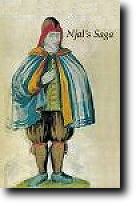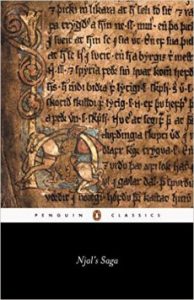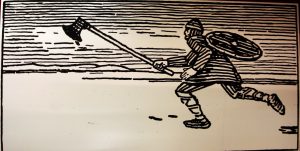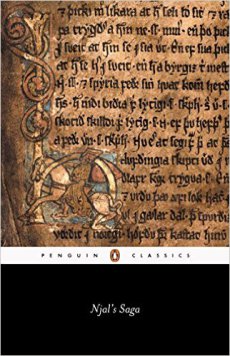Njáls saga – Icelandic saga – 13th cc
Posted by Sterling on 22/1/2013, 1:01:20

The free Kindle translation called “Burnt Njal” by George Dasent is to be avoided. It was published in 1861 and is doubtless of historical importance to scholars. However, the Victorian English (very different from the apparent bluntness of Old Icelandic), combined with deliberately archaic word choices makes for a less than satisfactory reading experience.
The most readily available translation (both print and kindle) is Robert Cook’s recent (2002) Penguin translation. Several reviewers have complained that it is dry and over-scholarly. It attempts to preserve the prose style of the original, but many think that Cook has merely raised “another barrier to appreciation of the saga.”
The translation that I read, the former Penguin translation of Magnus Magnusson (1960), impressed me deeply. It is only available used at this time, but if you can lay hands on a copy, I strongly recommend it.
~
Posted by Steven on 22/1/2013, 9:12:21, in reply to “Re: Njals Saga translations”
I have a 1955 translation by Carl F. Bayerschmidt and Lee M. Hollander published by Wordsworth Classics. This is a publisher that usually does cheap reprints of works in the public domain, but this seems to be an exception, and it has a nice set of modern maps, family trees, notes, and other reading aids.
There is no preview of the Magnusson translation on Amazon, so I can’t compare the two, but I did compare mine with Cook’s translation. Looking just at the first paragraph of the saga, where Cook says “his nickname was Gigja” Hollander says “who was known also as Mord Fiddle.” And where Cook says “the Rangarvellir district” Hollander says “the Rangá River district.”
~
Posted by Steven on 2/2/2013, 12:12:21, in reply to “Njals Saga translations”
(non-spoiler – though I don’t think spoilers are an issue in this sort of literature)
I am about a third of the way through and enjoying it very much. It is a fascinating look at a unique society and very readable.
One aspect of that society that isn’t explained in the introduction or notes to my edition is the relationship they translate as “foster father.” Thjóstólf, for example, is Hallgerd’s foster father, and apparently on the basis of that relationship he commits murders on her behalf. Her real father is still living. Later on it mentions that Njál takes his new daughter-in-law’s brother as his foster son. It seems that this is equivalent to the Christian concept of a godfather. Has anyone read an explanation of this “foster father” relationship and what it entails?
In the introduction to my edition it discusses the distinction between “guilt societies” and “shame societies.” We live in a guilt society where actions are supposed to be regulated by conscience and the goal is righteousness. Medieval Iceland, however, was a shame society where actions are regulated by reputation and the goal is honor. They mention that Homer’s Greece was also a shame society. I would think that Japan, at least through WWII, is another example, as are the traditional societies of Albania and the Gypsies where blood feuds are common.
The role and power of women in Njál’s world is interesting. They have a say in their marriage and can initiate divorce. They are the de facto managers of the household. And if Hallgerd is any example, they can initiate murder with nothing more to fear in return than a slap on the face. It also appears that chastity and fidelity were not valued highly. Much of the the goings-on are no doubt played down because Iceland had been Christianized by the time the saga was recorded, but there is one instance where Otkel’s wife (I believe) tells a Norwegian that he owes it to them to join in their fight because they give him their daughter Gudrun to sleep with while he was visiting.
Another thing I find interesting is that Icelandic society seems to run counter to the general rule that the harsher the climate, the more benign the human culture. Independent People by Halldor Laxness gives a vivid picture of the harshness of the Icelandic winter, and you would think these people would put all their energies into simply surviving instead of riding around killing each o.
Posted by Sterling on 2/2/2013, 16:18:46, in reply to “Re: Njals Saga”
The introduction to my edition did not address the “foster-father” question. It was, I believe, fairly common in medieval society for a child to be raised in another family. This was sometimes to strengthen bonds (not unlike arranged marriages), sometimes to end a feud, sometimes simply to give a child advantages or influences that he (or sometimes she) could not get at home. If the biological parents were still living, this relationship did not involve taking actual legal responsibility for a child, as in adoption. I don’t know any specifics of the Icelandic tradition.
I had not heard of the rule that the harsher the climate, the more benign the people. It would seem that the Vikings (and Norse in general) are a major exception. The Mongols come to mind, as well. We learn in Cloud Atlas that the most peaceful people in the world appear to be the Moriori of the Chatham Islands, who were all but wiped out in a genocidal attack by Maori from Mew Zealand. The Chathams do not enjoy a Hawaiian paradise climate, but they are certainly temperate, not harsh.
As I read the saga, it appears that most of the feuding and killing is taking place during the warmer seasons. Further, “Njal’s country” is in southern Iceland, near the coast, which I understand is warmer and milder than the rest of the country.
~
Posted by Sterling on 3/3/2013, 15:40:45, in reply to “Re: Njals Saga “
I think it’s interesting how modern the story feels in many ways, especially all the legal activity. I found that quite surprising in an epic. Can you imagine Menelaus suing Paris for stealing his wife? Or Oedipus pleading “extenuating circumstances” in killing his father and marrying his mother? I know it sounds funny, but the court scenes struck me as that incongruous.
Generally in epics, character is quite one-dimensional and static. Not In Njal. The characters are very well drawn and often ambiguous. The “good guys” and the “bad guys” are not nearly as clear-cut as one might expect.
~
Posted by guillermo maynez on 3/3/2013, 22:09:18, in reply to “Re: Njals Saga “
I agree. Although, sadly, all those legal proceedings and technicalities seem to be not that effective to prevent violence! It certainly is amazing that they had all that legal infrastructure, but the tribal mentality is pervasive.
When comparing the globalized, modern society to the tribal, clanish one, one frequently hears or reads how sad it is that the extended family has been dissolved. Certainly there are things to lament in that, but on the other hand “Njal’s Saga” is a shocking example of how pernicious the concept of “honor” can be. Every killing results in a string of vengeance seemingly endless. I cringed at the episode of Mord convincing Njal’s sons of the supposed bad intentions on the part of Holkud Thrainsson, which resulted in his assassination based solely on suspicions and misgivings.
I also agree on the subject of character ambiguity: Skarphedin is a case in point. Initially, and honoring his father’s moral stature, he is a brave and sensible man, but gradually he descends into recklessness, arrogance, and folly, until his whole family’s demise is brought about. Njal is undoubtedly a fascinating character, and his story is only to be lamented.
~
Posted by Steven on 4/3/2013, 9:37:25, in reply to “Re: Njals Saga “
Several of the images from Njals Saga were strikingly similar to scenes from the Old West–feuding ranchers and such. The 19th century in the US was also a time when people went crazy with lawsuits, but they were mostly over property rights and commercial affairs, not indemnity for human life.
The saga gives a good illustration of the breadth and power of Norse culture. They controlled most of the British Isles (Dublin was founded by Norwegians), all of the northern shores of Europe, and the heart of Russia. They were well-acquainted with both Rome and Byzantium.
It’s noteworthy how little impact the introduction of Christianity had on the cycle of violence. There doesn’t seem to be anyone standing up to oppose the old ways. The customs were probably so deeply ingrained that changing them was inconceivable. The author, who is writing two centuries after the fact, makes Njal, who is as close as anyone in the saga comes to being a pacifist, the focus of the tale, but even then there isn’t any overt condemnation of the killings.
Reading something like this also makes you see how deeply ingrained our own cultural values are. We might disagree over whether violence is ever justified in cases of revenge, but I think any modern reader is going to be stunned at the idea that Gunnar has to pay for killing men in his heroic self-defense when he was ambushed and heavily outnumbered. And it’s even more unthinkable that those who ambushed him can go before the law as the injured party. Nothing in my reading of medieval Chinese and Japanese literature is as alien to our modern way of thinking as this.
What did you think of the use of magic in the tale? There are just a couple of instances, and very little is made of it. Perhaps there was more sorcery in the original oral legends, but the Christian chronicler took out all that wasn’t essential to the plot, and downplayed the rest–just guessing. It’s somewhat reminiscent of some of the Arthurian legends where sorcery and Christianity coexist.
~
Posted by Sterling on 4/3/2013, 21:00:13, in reply to “Re: Njals Saga “
: The saga gives a good illustration of the breadth and
: power of Norse culture. They controlled most of the
: British Isles (Dublin was founded by Norwegians), all
: of the northern shores of Europe, and the heart of
: Russia. They were well-acquainted with both Rome and
: Byzantium.
Agreed. I’ve always thought of Iceland as very isolated (even today). While journeys were certainly not casual, traveling to Scandinavia or the British Isles is treated in the saga as nothing unusual or remarkable. Norse culture seems to be disregarded by many of us as a horde of itinerant raiders in the Dark Ages. This is odd, in a way, because documents like Njal give us a better and more realistic window into the tenth century — a time that may seem more remote than the ancient Greeks or Romans. It seems to me worth noting, however, that at least some of the culture reflected in Njal is purely Icelandic, rather than more generally Norse. The Althing, especially, is Icelandic. It is still, after over 1000 years, the parliament of Iceland.
: It’s noteworthy how little impact the introduction of
: Christianity had on the cycle of violence.
True, although it seems to me that given the copious violence of all kinds perpetrated by “Christian ” nations, the impact of Christ’s teachings of peace and forgiveness have always been pretty much ignored. Plus, I think you are correct, Steven, that the cultural norms did not change overnight, even though the conversion to Christianity seemed to be surprisingly swift and little opposed.
: Reading something like this also makes you see how
: deeply ingrained our own cultural values are. We might
: disagree over whether violence is ever justified in
: cases of revenge, but I think any modern reader is
: going to be stunned at the idea that Gunnar has to pay
: for killing men in his heroic self-defense when he was
: ambushed and heavily outnumbered. And it’s even more
: unthinkable that those who ambushed him can go before
: the law as the injured party. Nothing in my reading of
: medieval Chinese and Japanese literature is as alien
: to our modern way of thinking as this.
Yes, very surprising indeed. I suppose that I genuinely believed that self-defense was a universal defense. For the Icelandic, apparently killing is killing.
It fascinated me that one could actually hire a lawyer and that he would be as wily with underhanded tricks as any modern attorney. Guillermo, I agree that Skarphedin may have the most striking character arc. I was dumbfounded that the evil Mord was coerced into representing Kari and the others Njal supporters at the Althing.
:: What did you think of the use of magic in the tale?
: There are just a couple of instances, and very little
: is made of it. Perhaps there was more sorcery in the
: original oral legends, but the Christian chronicler
: took out all that wasn’t essential to the plot, and
: downplayed the rest–just guessing. It’s somewhat
: reminiscent of some of the Arthurian legends where
: sorcery and Christianity coexist.
Well, first of all, I was actually surprised at how little magic there is in the saga and how naturalistic most of it seems. Most of the epics with which I’m familiar are drenched in magic, gods, and sorcery. Njal reminded me a bit of Romance of the Three Kingdoms. It, too, has magic, but very sparing.
Pretty much everybody before the Renaissance (heck, make that the Enlightenment) seems to have believed in magic and supernatural events. It would not have seemed remarkable to the original audience of Njal. Many, even most, stories written before the sixteenth century involve some magic. Even the bible has the unforgettable scene of the Witch of Endor conjuring the ghost of Samuel for Saul.
Christianity and magic co-exist many places. Think of the Catholic imagery in voodoo (especially Louisiana style) and santéria. Plus, it is worth considering that walking on water might as easily be considered magic as a miracle.
~
Posted by Steven on 5/3/2013, 9:12:57, in reply to “Re: Njals Saga “
I recently read The Isles: A History by Norman Davies, and he sheds much light on the disregard of Norse culture and on the Northmen’s role in European history. Davies is a champion of neglected European nationalities. In his history of the British Isles he concludes each chapter with an essay on the historiography of the era, showing how our modern perceptions have been shaped by earlier prejudices.
The history texts and curricula of the English-speaking world are largely based on the work of 19th century Englishmen. They were not only anglocentric–discounting the Celtic cultures of Scotland, Wales and Ireland–but also very pro-German. Queen Victoria was of German extraction and still spoke German at home. This led to playing up the importance of the Saxons in English history and denigrating their rivals, the Celts, Danes and Norwegians. It also meant portraying the Normans as evil overlords. So the Northmen get a bad rap–so much so that they are generally known collectively as “Vikings,” which means raiders. (There is a modern equivalent when Islamists refer to Americans and Europeans as “Crusaders.”)
Another factor is that some cultures simply have more staying power than others, and prevail even against enemies that have more physical might. Chinese culture is one example–three times China was conquered, and the victors wound up as Chinese as their subjects. For whatever reason, Norse culture failed to stand up in encounters with others. After two generations the Normans were as French as the French, and there was hardly a trace of their Scandinavian origins. Similarly the Danes and Norwegians who settled much of Great Britain and Ireland weren’t driven out–they were just quietly assimilated into the stronger cultures of the Saxons, Scots and Irish. So the Norsemen came and went in northern Europe, leaving little trace of their passing when compared to other examples such as the Moors in Spain.
All of this points to Iceland as a very interesting cultural laboratory. I can’t think of another example where a nation of such size was born in historic times by a literate or near-literate population discovering and settling a land with no indigenous population. It would be fascinating to study how their culture has evolved in such relative isolation and purity, and, of course, the sagas are the starting point.
Sorry for running on about this, but it’s a very interesting topic.

Posted by Sterling on 5/3/2013, 13:18:08, in reply to “Re: Njals Saga “
Thank you, Steven. A very interesting and thought-provoking post. I had never really considered how some invading cultures seem to be absorbed with hardly a trace, while other cultures leave indelible marks, even when assimilated.
~
Posted by guillermo maynez on 8/3/2013, 13:25:54, in reply to “Re: Njals Saga “
Undoubtedly, this is a very interesting subject. Steven pointed out how funny it is to imagine people from other myths suing each other in any court of law, and that points out how advanced Icelanders were in their civilization, when compared with other peoples at that time – or at a similar stage of development. I highlighted how all those legal or legalistic procedures failed to prevent violence, but nevertheless they were the seed that allowed them later to become the law-abiding societies the Nordic countries are to this day. Sadly, there seems to be here a strong argument in favor of the advantages of settling lands with no previous indigenous populations (or wiping them out, like the English did in North America): nations may begin afresh in the absence of ancestral tribal habits. I’m sure there must be several exceptions to this rule, and of course the legal inclinations of the conquerors necessarily play a role, but at least there seems to be a trend exemplified by the Icelanders.
The Spanish conquests in the Americas are a negative example: on the one hand, they brutally repressed the indigenous forms of organization, but to a great extent, the conquerors became affected by those very same cultures, plus the fact that Medieval Spain was anything but a law-abiding people. The Catholic religion, when implanted in the Americas, became transformed into a mix with previous religions. In Mexico, for example, the devotion to the Coatlicue (the mother-goddess) simply derived into the cult of the Virgin of Guadalupe, practically intact, and many old habits of the Aztecs, Mayas, and other cultures survive in contemporary points of view and social customs. Thus, in many respects, current White people in Latin America behave more like natives than like Spanish (qualifications of this statement could, no doubt, ignite a strong debate among specialists, but I think the main argument stands). And this is connected with another point made by Sterling and Steven: that Christianization didn’t prevent the ancient habits to persist, in the form of continued tribal revenges and honor crimes. It’s hard to erradicate so pervasive visions, as the brutality exhibited by newly-Christian societies shows. “Njal’s Saga” is fascinating, both as a literary work, and as a historical document…
~
Posted by guillermo maynez on 11/3/2013, 14:32:43, in reply to “Re: Njals Saga “
Another aspect of “Njal’s Saga” that I wanted to comment is the role and character of women. Practically all women in this story are strong-willed, independently-minded persons. Although certain roles traditionally assigned to women, like serving food and not being included in the body politic remain, there seems to be a tradition of larger room for their opinions and actions. Small wonder that the Scandinavian Walkyrias have been pioneers in many of the Feminist causes of the last century…
~
Posted by Steven on 12/3/2013, 9:05:14, in reply to “Re: Njals Saga “
: Another aspect of “Njal’s Saga” that I wanted
: to comment is the role and character of women.
Our discussion here has gotten rather strung out, so I’m just going to re-post what I said in my first message as it agrees with what you have just said:
The role and power of women in Njál’s world is interesting. They have a say in their marriage and can initiate divorce. They are the de facto managers of the household. And if Hallgerd is any example, they can initiate murder with nothing more to fear in return than a slap on the face. It also appears that chastity and fidelity were not valued highly. Much of the the goings-on are no doubt played down because Iceland had been Christianized by the time the saga was recorded, but there is one instance where Otkel’s wife (I believe) tells a Norwegian that he owes it to them to join in their fight because they give him their daughter Gudrun to sleep with while he was visiting.
So women, at least among the landowning classes, had more autonomy in 11th century Iceland than they did in 18th century England (e.g. Clarissa).
~

- Related:
- Book Reviews















